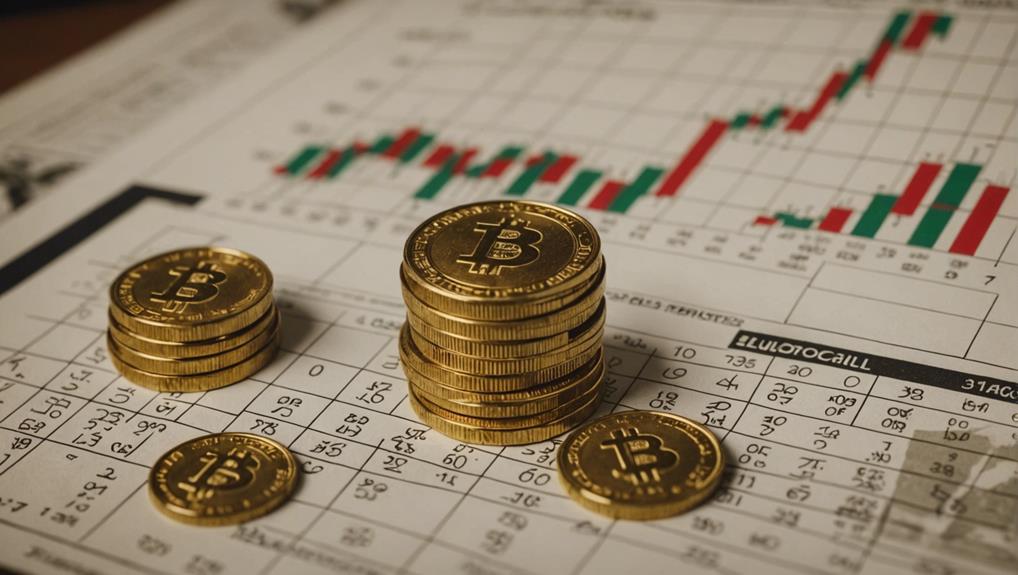What Historical Data Shows About Investing in Gold's Performance?
Historical data reveals that gold has often been a reliable investment, particularly during periods of economic uncertainty and market volatility. From the post-Bretton Woods era to contemporary market fluctuations, gold has shown remarkable resilience and long-term growth.
Its effectiveness as a hedge against inflation and currency devaluation distinguishes it from other asset classes like stocks and bonds. Analyzing gold's performance across different periods and economic conditions can provide valuable insights into its potential for future investments.
Interested in exploring more about this intriguing asset?
My Quick Highlights
Gold's value surged significantly post-1971, peaking at approximately $2,065 per ounce in August 2020. Between 2005 and 2020, gold outperformed the Dow Jones Industrial Average (DJIA), demonstrating its potential during periods of market instability. From 1971 to 2019, gold achieved an average annual return of 10.6%, surpassing real estate's 8%. During economic uncertainty, gold often outperforms stocks and bonds, serving as a safe haven. Geopolitical tensions and inflation concerns in 2021 and 2022 also saw gold outperforming stocks, underscoring its role in volatile times.
Historical Gold Price Trends

Historical gold price trends reveal how this precious metal has reacted to various economic and geopolitical events over the decades.
From 1934 to 1971, gold prices were fixed at $35 per ounce under the Bretton Woods system.
The end of this system led to a significant surge in gold's value, with prices reaching over $800 per ounce in the late 1970s and early 1980s.
This historical performance underscores gold's volatility, often spiking during periods of uncertainty.
Gold reached an all-time high of approximately $2,065 per ounce in August 2020 amid global economic turmoil.
Its long-term value has steadily increased, making gold a popular investment choice for those seeking a hedge against economic instability.
Gold Vs. Other Asset Classes
When comparing gold to other asset classes, you'll find fascinating contrasts in performance and stability. Gold often shines during economic uncertainty, which can make it a safer bet compared to stocks or bonds in volatile times.
While stocks generally outperform gold in the long term, and bonds offer similar returns over decades, each asset class has its unique advantages depending on your investment horizon and risk tolerance.
Gold Vs. Stocks Analysis
Comparing gold to stocks reveals distinct advantages and risks associated with each. Stocks generally offer higher long-term returns, evidenced by the DJIA's 991% rise from 1990 to 2020 compared to gold's 360% increase. However, gold often excels during economic uncertainty, making it a valuable tool for portfolio diversification and a hedge against inflation.
Examining mid-term performance from 2005 to 2020, gold's 330% gain significantly outpaced the DJIA's 153% rise. This trend highlights gold's potential to outperform stocks during specific periods, particularly when market conditions are unstable.
Recent trends in 2021 and 2022 saw gold surpassing stocks due to geopolitical tensions and inflation concerns. This performance underscores gold's role in providing stability during market volatility, often acting as a safe haven when stocks decline.
Gold Vs. Bonds Performance
Gold's performance relative to bonds highlights its potential as a robust investment, particularly during periods of economic instability. From 1990 to 2020, gold increased by around 360%, while corporate bonds yielded similar returns over the same 30-year period.
Over a shorter timeframe, from 2005 to 2020, gold's 330% increase significantly outpaced bonds, which saw lower returns compared to both stocks and gold.
In times of geopolitical uncertainty and inflation concerns, gold tends to outperform traditional assets like bonds. For instance, gold's performance in 2021 and 2022 was superior due to rising inflation and global tensions.
These trends illustrate that gold can be a compelling investment choice compared to bonds, especially during unstable economic conditions.
Gold Vs. Real Estate
Gold has shown resilience against economic instability, but comparing its performance with real estate highlights unique advantages and challenges for investors.
Both gold and real estate serve as solid hedges against inflation, yet they differ in several key aspects:
- Average Returns: Between 1971 and 2019, gold achieved an average annual return of 10.6%, surpassing real estate's 8%.
- Stability: Real estate generally offers more stability and lower volatility compared to gold.
- Tangible vs. Liquid Assets: Real estate provides tangible assets and potential rental income, whereas gold is more liquid and easily tradable.
- Economic Sensitivity: Gold has a stronger correlation with economic uncertainty and geopolitical events.
Including both assets in your portfolio can help balance risks and returns.
Gold as an Inflation Hedge

Gold often shines as a reliable hedge against inflation during times of rising prices, preserving purchasing power. Historically, gold has maintained its value when inflation spikes. As prices climb, the value of gold typically rises, making it an effective inflation hedge. This correlation between gold and inflation is well-documented, with gold frequently outperforming other assets during inflationary periods.
Its scarcity and intrinsic value contribute to its ability to serve as a stable store of wealth. Investors frequently turn to gold to protect their assets from the eroding effects of inflation, relying on its historical consistency. Holding gold can safeguard wealth against the diminishing purchasing power caused by inflation.
Portfolio Diversification
Moreover, when you incorporate gold into your investment portfolio, you'll find that it offers a valuable risk mitigation strategy due to its low correlation with traditional assets like stocks and bonds.
This means that gold can help balance your portfolio by potentially reducing overall risk, especially during economic downturns.
Furthermore, gold acts as a hedge against inflation, providing stability and enhancing long-term returns.
Risk Mitigation Strategy
Investing in gold can effectively mitigate risks in your portfolio by counterbalancing stock market volatility. Integrating gold enhances risk management and achieves better portfolio diversification, especially during periods of economic uncertainty. Historical data demonstrates that gold's performance can act as a stabilizing force amid market fluctuations.
Consider these benefits:
- Risk Reduction: Gold's low correlation with traditional assets like stocks and bonds reduces overall portfolio risk.
- Economic Hedge: During economic uncertainty, gold often retains value, serving as a reliable hedge.
- Stability: Including gold can boost portfolio stability by offsetting losses from other investments.
- Long-term Gains: Gold's historical performance suggests it can improve long-term risk-adjusted returns.
Incorporating gold strategically strengthens your financial resilience.
Asset Correlation Analysis
Analyzing the correlation between gold and traditional assets reveals its potential to enhance portfolio diversification and stability. Gold exhibits a low correlation with stocks, meaning it doesn't move in tandem with equities. This characteristic makes gold a valuable component in asset allocation.
Including gold in your portfolio can reduce overall risk, particularly during economic downturns when demand for gold typically rises. Historically, gold's performance has underscored its role as a safe-haven asset, offsetting losses in other investments.
The influence of the gold standard on its value further reinforces its stability. Incorporating gold can lead to better risk-adjusted returns over time, offering a more balanced and resilient investment strategy.
Inflation Hedge Benefits
Gold has consistently proven to be a reliable safeguard against inflation, protecting wealth as prices rise. Its intrinsic value and scarcity support long-term price appreciation. Incorporating gold into your investment strategy can enhance portfolio diversification, offering a buffer against inflation's negative impact on traditional assets.
Consider the benefits of using gold as an inflation hedge:
- Wealth Preservation: Gold maintains its value over time, safeguarding assets from erosion.
- Risk Management: Its historical performance helps mitigate risks in volatile markets.
- Improved Returns: Adding gold can boost overall returns during inflationary periods.
- Stabilized Volatility: Gold's stability can balance fluctuations in other investments.
Using gold for portfolio diversification ensures wealth remains protected and resilient.
Gold During Economic Uncertainty

Gold is recognized as a reliable safe-haven asset, particularly during economic uncertainty. When market instability occurs, investors frequently seek out gold bullion due to its perceived stability. Historically, gold's value tends to rise during financial crises and geopolitical tensions, making it a favored option for hedging against economic turmoil.
In times of economic stress, the demand for gold increases, reinforcing its reputation as a trustworthy investment. Holding gold can shield your portfolio from the negative impacts of market volatility. Its consistent performance during uncertain periods highlights why gold continues to be a fundamental choice for risk-averse investors aiming to safeguard wealth amidst financial ambiguity.
Factors Influencing Gold Prices
Understanding the factors that influence gold prices can help you make more informed investment decisions. Key elements include:
- Geopolitical instability: Conflicts or trade tensions often drive investors to gold as a safe haven, pushing prices up.
- Inflation rates: Gold is commonly viewed as a hedge against inflation. When inflation rates rise, the value of currency falls, making gold more attractive.
- Interest rates: Central banks' changes in interest rates can affect gold prices. Higher interest rates increase the opportunity cost of holding gold, often leading to lower prices.
- Economic data: Releases like GDP growth or unemployment rates can cause fluctuations. Strong economic data may lower gold prices as investors seek higher-yielding assets.
Considering these factors can sharpen your investment strategy.
Risks of Investing in Gold

Investing in gold comes with several risks that you should carefully consider before making any decisions. One major risk is market volatility, which can cause significant price fluctuations. Currency devaluation can impact gold's value, particularly if the currency you're using weakens. Storage costs for physical gold add to your overall expenses, including insurance and security measures. Inflation and central bank policies also influence gold's performance, which can be either positive or negative.
| Risk Factor | Description |
|---|---|
| Market Volatility | Gold prices can fluctuate widely due to market conditions. |
| Currency Devaluation | Changes in currency value can affect gold's purchasing power. |
| Storage Costs | Storing physical gold incurs additional costs for security. |
Factors like inflation and central bank policies also play a crucial role in determining the performance of gold investments. While these influences can be beneficial, they can also introduce further risk, making it essential to stay informed about economic trends and policy shifts.
Ways to Invest in Gold
When exploring ways to invest in gold, you have several options, each with its unique benefits and risks.
You can own physical gold like coins or bars, or you might prefer gold investment funds such as ETFs that provide exposure to gold prices without the need for storage.
Alternatively, investing in gold mining stocks or gold futures offers other avenues, each with its own set of considerations.
Physical Gold Options
Investing in physical gold allows you to directly own the precious metal through various forms such as bars, coins, and jewelry. This tangible ownership provides both security and a sense of personal possession.
- Gold Bars: Available in various sizes, gold bars are often the purest form of physical gold investment.
- Gold Coins: Widely recognized options include the American Eagle and South African Krugerrand.
- Gold Jewelry: This option combines adornment with asset value, offering dual benefits.
- Secure Storage: Safeguarding your physical gold is crucial. Consider using safety deposit boxes or home safes.
Owning physical gold can effectively diversify your investment portfolio.
Gold Investment Funds
Gold investment funds provide an efficient way to gain exposure to gold without the challenges of storing physical metal. These funds include gold ETFs, mutual funds, and gold mining stocks. Gold ETFs, such as SPDR Gold Shares (GLD), are backed by physical gold and are popular for their liquidity and ease of trading.
Mutual funds that invest in gold mining companies offer exposure through equities, allowing you to benefit from the profitability of these companies. Another approach is investing in gold mining stocks, though this carries the added risk of company performance.
These gold investment funds offer diversification and liquidity compared to owning physical gold, making them a versatile option for your portfolio.
Long-Term Investment Potential

Gold's long-term investment potential is underscored by its historical returns and stability. From 1971 to 2019, gold achieved an average annual return of 10.6%, making it competitive with global stocks.
Here are key reasons why gold is a solid investment choice:
- Gold ETFs: These funds provide a convenient way to invest in gold without the need to own physical bullion.
- Gold Futures: Contracts that allow speculation on gold prices, offering opportunities for strategic investments.
- Central Banks: Their holdings and purchases of gold often influence market stability and prices.
- Hedge Against Inflation: Gold's ability to protect against currency devaluation makes it a reliable long-term investment.
These factors demonstrate gold's potential to preserve wealth and offer growth opportunities.
Key Considerations for Gold Investing
Exploring gold investing requires attention to market trends, investment vehicles, and economic indicators. Gold ETFs (exchange-traded funds) allow investment without holding physical gold, offering liquidity and ease of trading.
Monitoring central bank activities and gold reserves is crucial, as these factors can significantly influence prices. Understanding the dynamics of gold supply, including mining production and geopolitical events, is essential for predicting market movements.
Gold often performs well during economic uncertainty, serving as a hedge against inflation and currency devaluation. To optimize your portfolio, consider diversifying your strategy with a mix of physical gold, ETFs, mining stocks, and futures.
Conclusion
Investing in gold has proven to be a reliable strategy, particularly during economic downturns. Historical data shows gold's strong performance and its ability to offer a hedge against inflation and currency devaluation.
While it's important to consider the associated risks, gold can diversify your portfolio and provide stability in uncertain times. When assessing gold's long-term investment potential, weigh all factors and investigate various investment methods to make informed decisions.
The Gold Information Network
11900 Biscayne Blvd, Ste 127B, Miami, FL 33181
(305) 449-9094
https://goldinfo.net
source https://rondewitt.com/historical-data-investing-gold-performance/
Comments
Post a Comment